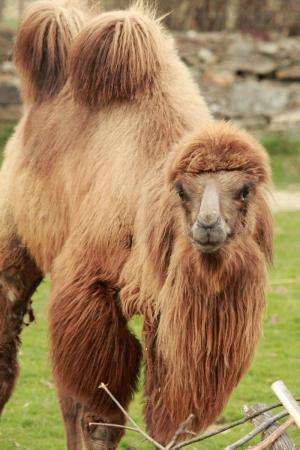Decoding the genome of the camel

By sequencing the genome of a Bactrian camel, researchers at the Vetmeduni Vienna have made a significant contribution to population genetic research on camels. The study has laid the foundation for future scientific work on these enigmatic desert animals. A blood sample from a single Bactrian camel with the evocative name of "Mozart" provided the genetic raw material for the work, which was undertaken by Pamela Burger at the Institute of Population Genetics.
Camels are divided into two species, the one-humped dromedary and the two-humped Bactrian camel. Whether equipped with one or two humps, camels are precious in desert regions throughout the world. Their ability to carry heavy loads over long distances makes them ideally suited for transportation. In addition, camels are able to survive for weeks in hostile environments without food and water. Despite the extremely arid conditions, camels still provide enough milk for human consumption and also have an important role as a source of meat. Camels are specialists when it comes to adapting to the environment and have been characterized as sustainable food producers.
Focusing on camel domestication
Pamela Burger heads one of the few research groups in Europe that study camel genetics. Burger and her colleagues are primarily interested in the domestication of camels, which took place around 3,000 to 6,000 years ago. Genetic data provide important clues on the breeding strategies and selection processes that were applied by humans at that time. The DNA code also represents a rich resource for addressing questions on phylogenetic relationships between animals. Burger is one of the first scientists to sequence large parts of the genome of a Bactrian camel and make it available to the public.
Milestone in camel genetics
Until recently, the genetic code of the Camel had not been fully analysed. Genetic research on these animals was therefore difficult or even impossible. In contrast, the entire genetic information of the human genome was available as long ago as 2003 and the genetic code of various animals and plants is publicly available, giving researchers access to an enormous set of data. To date, the lack of basic genetic data has severely hampered studies of camel genetics. Pamela Burger and her team are pioneers in presenting this essential dataset.
Relationship among the one- and the two-humped
The scientists were able to find 116,000 so-called SNPs (single nucleotide polymorphisms) in the genetic sequence of the Bactrian camel. SNPs are single base-pair changes within a DNA strand that provide the basis for studying relationships among species and between single animals. The genetic relationship between the Bactrian camel (Camelus bactrianus) and the dromedary (Camelus dromedarius) is close. 85 percent of the genomic sequences expressed in the dromedary can be found in the Bactrian camel. Burger explains, "Mozart's genome provides us with the basis for further comparative research on other camelids such as dromedary, lama and alpaca."
More information: The publication "Estimating the population mutation rate from de novo Bactrian Camel Genome Assembled and Cross-Species Comparison with ESTs Dromedary" by Pamela A. Burger and Nicola Palmieri was published as "Editor's choice" in the Journal of Heredity. jhered.oxfordjournals.org/cont … 8/jhered.est005.full
Provided by University of Veterinary Medicine -- Vienna



















